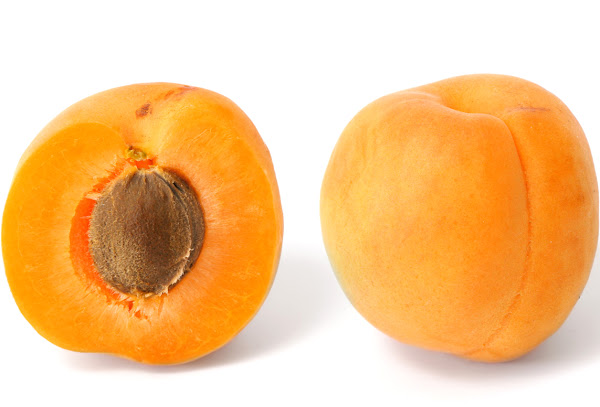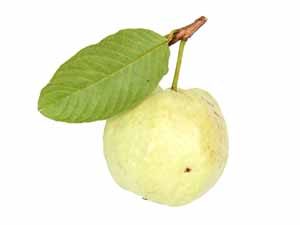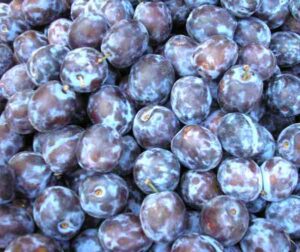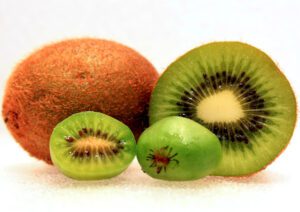Apricot farming is a very old business. Currently it is a very familiar and popular fruit in many countries throughout the world. Actually, it has been planted and cultivated for many centuries.
Apricot is a fruit and belongs to the ‘Rosaceae’ family and genus ‘Prunus’. The apricot tree is small (between 26 and 39 feet tall), with a trunk up to 16 inches in diameter and a dense, spreading canopy.
Leaves of the tree is ovate, 5–9 cm (2.0–3.5 in) long, and 4–8 cm (1.6–3.1 in) wide, with a rounded base, a pointed tip, and a finely serrated margin.
The flowers are 0.8 to 1.8 inches in diameter, with five white to pinkish petals. The flowers are produced singly or in pairs in early spring before the leaves.
The fruit is a drupe similar to a small peach, 0.6 to 1.0 inches diameter, from yellow to orange, often tinged red on the side most exposed to the sun. Surface of the fruits can be smooth or velvety with very short hairs.
The flesh is generally firm and not very juicy. Taste of the fruits can range from sweet to tart. The single seed is enclosed in a hard, stony shell, often called a “stone” or “kernel”, with a grainy, smooth texture except for three ridges running down one side.[1]
Apricot actually first appeared in English in the sixteenth century as abrecock from the Middle French, aubercot, or later from Portuguese, albricoque.
The specific name armeniaca was first used by Gaspard Bauhin in his Pinax Theatri Botanici, referring to the species as Mala armeniaca, ‘Armenian apple’.
A 2019 genetic study concludes that apricots were independently domesticated three times, twice in Central Asia and once in China, with extensive cross-pollination between wild and domesticated species across Eurasia.
According to the UN Food and Agriculture Organization, total world production of apricots was 4.3 million tones in the year of 2017. Top producer was Turkey with 23% of total production. And other major apricot producing countries were Uzbekistan, Italy, Algeria and Iran.
However, commercial apricot farming is a very good and profitable business. Here we are trying to describe more about this agribusiness.
Apricot Nutritional Benefits
Apricot is a very nutritious fruit. It is rich in many vitamins and minerals. It is low in calories and fat while also an excellent source of vitamins A and C.
A 100 gram raw apricot supply 48 calories and are composed of 11% carbohydrates, 86% water, 1% protein and less than 1% fat. 2 fresh apricots provide the following nutrients;
- Calories: 34
- Carbs: 8 grams
- Fat: 0.27 grams
- Fiber: 1.5 grams
- Protein: 1 gram
- Vitamin A: 8% of the daily value
- Vitamin C: 8% of the daily value
- Vitamin E: 4% of the daily value
- Potassium: 4% of the daily value
However, apricot is very nutritious and healthy for all types of people. Here we are trying to describe the top health benefits of consuming fresh apricot.
- Apricots are rich in numerous antioxidants, especially flavonoids. These antioxidants help to protect your body from oxidative stress, which is linked to many chronic diseases.
- Fresh apricots are good source of beta carotene, lutein, zeaxanthin, Vitamin C and Vitamin E. And all these nutrients help to protect your eyes against damage.
- Consuming fresh apricots will help you to protect against environmental damage from sunlight and pollution. Because it is rich in antioxidants. And thus this fruit may benefit your skin by lowering your risk of wrinkles and sunburn.
- This fruit is a good source of soluble fiber, which feeds your healthy gut bacteria and may boost digestive health.
- It is a great source of potassium.
- Apricots are naturally high in water, and you know water is important for staying hydrated. Proper hydration is vital for several aspects of health, including blood pressure and heart rate.[2]
- Some studies have found that, apricot is good for protecting the liver from oxidative stress caused by the ingestion of alcohol.
- Both fresh and dried apricots are widely available throughout the world. You can eat them on their own or add them to your favorite dishes, sides or desserts.
Advantages of Apricot Farming Business
Apricot farming is a very easy and simple business if you can do everything perfectly. Commercial business has many benefits or advantages.
You can start commercial dates farming for making good amount of profits. You can start this business, even if you are a beginner. Here we are shortly describing about the top advantages of starting commercial apricot farming business.
- Commercial apricot farming is not a new business. It is an established business and many people are already doing this for making money.
- Caring the apricot trees is relatively easy. So, you can take this opportunity for making good profits.
- Currently, apricots are available in many countries throughout the world.
- Demand and price of apricots are increasing gradually.
- The plants can grow almost everywhere.
- As commercial production is profitable, so you can take this opportunity for making an employment source. Especially, the educated unemployed young people can start such agribusiness instead of seeking for jobs.
- Production cost is not too high and the return is very good.
- Marketing apricots will be relatively easy, because it has already established it’s market.
- Consuming apricots on a regular basis has many health benefits. And you can enjoy fresh apricots if you start growing of your own.
How to Start Apricot Farming Business
Starting apricot farming business is relatively easy whether you start in small scale or commercially. The plants generally require less caring. So, the beginners can also start this business.

Apricot plants generally grow well in the dry temperate and mid-hill regions. Availability of full sun is very important for good growing of the tree. And almost all types of soil are good for apricot farming.
Here in this guide, we are trying to describe more information about apricot farming business from planting, caring to harvesting and marketing.
Select Good Location
First of all, select a very good location for growing apricot plants. Very fertile, well drained soil with exposure to full sun will be good for apricot farming.
Well drained soil is a must, because the apricot plants don’t like moist roots. Right pH level between 6.7 and 7.5 will be very good for growing apricot plants.
Prepare the Soil
You have to prepare the soil perfectly before planting the apricot plants. Well-drained, fertile soil is generally good for good growth of the plants.
Dig the pits size of 3 x 3 x 3 feet 1 month before planting. Fill every pit with a mixture of soil and around 50- 60 kg of well rotted farm yard manure. Also add 1 kg of single super phosphate, and 10 ml of Chorapyripos solution (10ml/10 liters of water).
Climate Requirements For Apricot Production
Apricot trees need chill hours of 600 to 900 every year at temperatures of 0°C to 8°C. Temperatures below 0°C are harmful for these plants. The ideal summer temperature is 37°C. And their production will hamper above 37°C temperature.
Apricot plants should be planted in full sun to maximize the yield. Avoid planting them in areas where they collect frost. Around 100 cm annual rainfall throughout the growth period of these plants will be good.
Choose a Good Variety
There are numerous apricot varieties available throughout the world to choose from. You should grow those varieties which are already available in your area. Consult with existing farmers in your area for better recommendations.
Prepare or Purchase Plants
Apricots are generally propagated by grafting or budding and T-budding, Tongue grafting and chip budding.
For raising rootstock, seeds should be collected from ripen wild apricots. These seeds require stratification for a duration of 45 days at 4°C to break dormancy.
Soak the seeds after stratification in 5 ppm Kinetin or 500 ppm GA3 solution for 24 hours before sowing.
Then sow the seeds 5 to 10 cm deep on nursery beds at a seed to seed spacing of 15 to 20 cm and the row to row distance should be between 25 and 30 cm.
Mulch the nursery beds after sowing and also water slightly. The seedlings will be ready with graftable size in one year after sowing. The seedlings of pencil thickness should be grafted with tongue method.
You can avoid all these steps mentioned above, if you purchase the ready plants from nurseries.
Planting
Prepare the land perfectly by following the steps mentioned above. Prepare the planting area in early spring.
The standard spacing should be between 20 and 25 feet. The spacing is generally based on the height of a standard apricot tree, which can grow anywhere between 20 and 30 feet tall.
Irrigate immediately after planting the small plants. And it is always recommended to plant the plants in the afternoon.
Caring
Apricot plants generally require less caring. Although, taking additional caring is very important for good growth of the plants and better production.
Caring the apricot plants is generally easy. Here we are trying to describe about the caring process of apricot farming business.
Fertilizing
Prepare the soil before planting in the above mentioned ways. Try to add as much organic contents as you can.
Watering
Adequate watering is required especially during fruit development stage in the month of April to May.
Frequency of irrigation depends on the soil type, age of the tree and weather conditions.
Provide irrigation at 8 to 10 days intervals during extreme hot and dry periods. Make good drainage system to avoid water logging in case of heavy rains.
Mulching
Mulching is very important, especially immediately after planting. Mulching not only helps to retain moisture into the soil, but also helps to prevent weeds.
Controlling Weeds
Controlling weeds is very important for apricot production. Because weeds consume most of the nutrients from soil.
Pre-emergence application of Atrazine or Diuron at the rate of 4 kg per hectare and post emergence application of Glyphosate at the rate of 800 ml per hectare or Gramazone at the rate of 2 liters per hectare is more effective for controlling the weeds.
Training & Pruning
Apricot trees are trained on modified center leader and ope vase system. 1 year old whip should be headed back at 70cm above the ground and 4 to 5 well spaced shoots should be allowed to grow in all directions, at the time of plantation.
Pruning is also required to give the tree a good shape. So, pruning should be carried out in first dormant season.
Pests & Diseases
Like other commercial crops, apricot plants are susceptible to various diseases whose relative importance is different in the major production regions as a consequence of their climatic differences.
For example, hot weather as experienced in California’s Central Valley often causes pit burn, a condition of soft and brown fruit around the pit.
Bacterial diseases include bacterial spot and crown gall. And fungal diseases include brown rot.
Dieback of branches in the summer is attributed to the fungus Eutypa lata, where examination of the base of the dead branch reveals a canker surrounding a pruning wound.
Other fungal diseases of the apricot plants are black knot, Alternaria spot and fruit rot, and powdery mildew.
Consult with an expert in your area for controlling all the diseases and pests.
Harvesting
Generally, the apricot fruits become mature in first week of May-June end depending upon the variety. The trees generally start bearing fruits from 5th year and attain maximum fruit bearing stage at 8 to 10 years of age. And the trees continue producing fruits up to their 35 years of age.
You can harvest the fruits manually. The fruits should be plucked after they change the surface color from green to yellowish, for fresh marketing.
Fully ripen apricot fruits can be harvested for drying, freezing and canning purposes.
These fruits are perishable, so extreme care should be taken after harvesting. And grade the fruits based on their size after harvesting, and pack in the wooden or plastic boxes. Apricots can be stored at 0°C for 1 to 2 weeks by maintaining 85% to 95% relative humidity.
Yield
It’s not possible to tell the exact yield. Exact yield depends on many factors. But average yield is 50 to 85 kg fruits per tree.
Marketing
Marketing apricots is relatively easy. Hope you will be able to easily sell your products in the local market. Although, you should set your marketing strategies before starting this business.
These are the common steps and ways for staring and operating a successful apricot farming business. It’s really easy. Hope this guide has helped you! Good luck & may God bless you!






